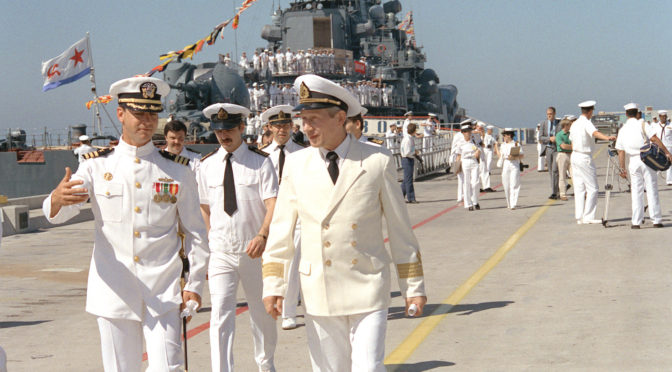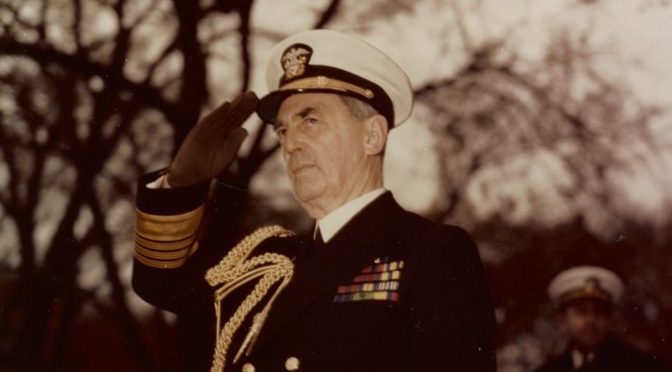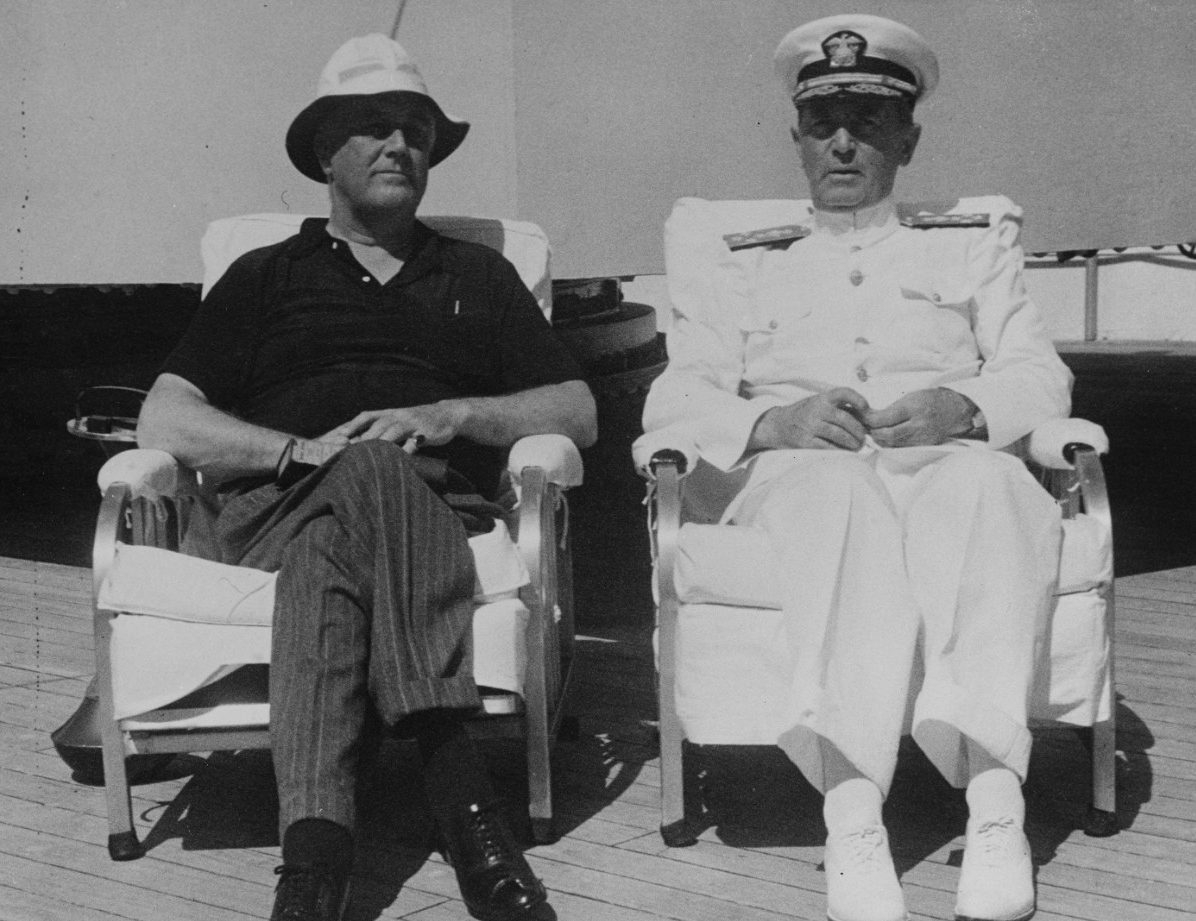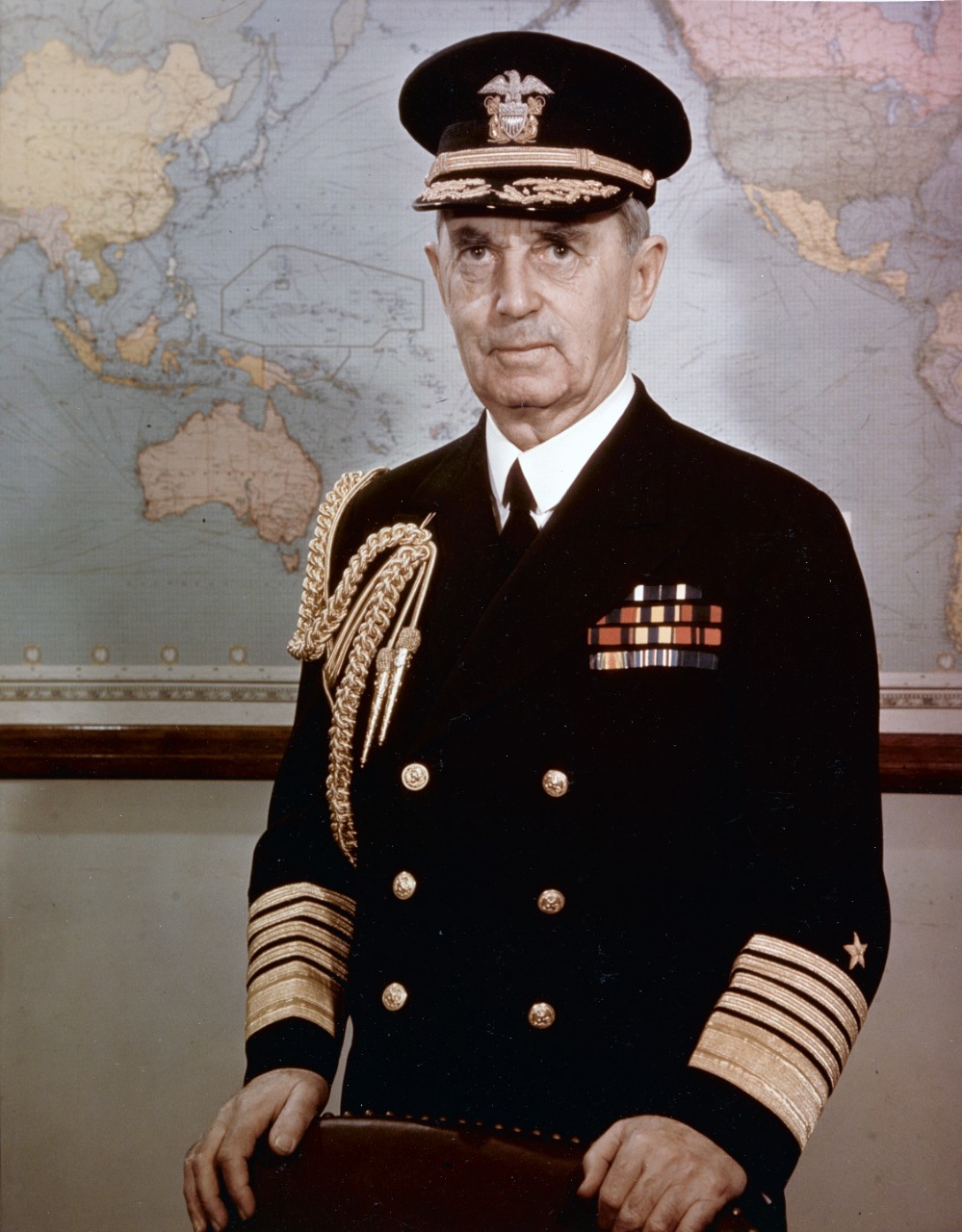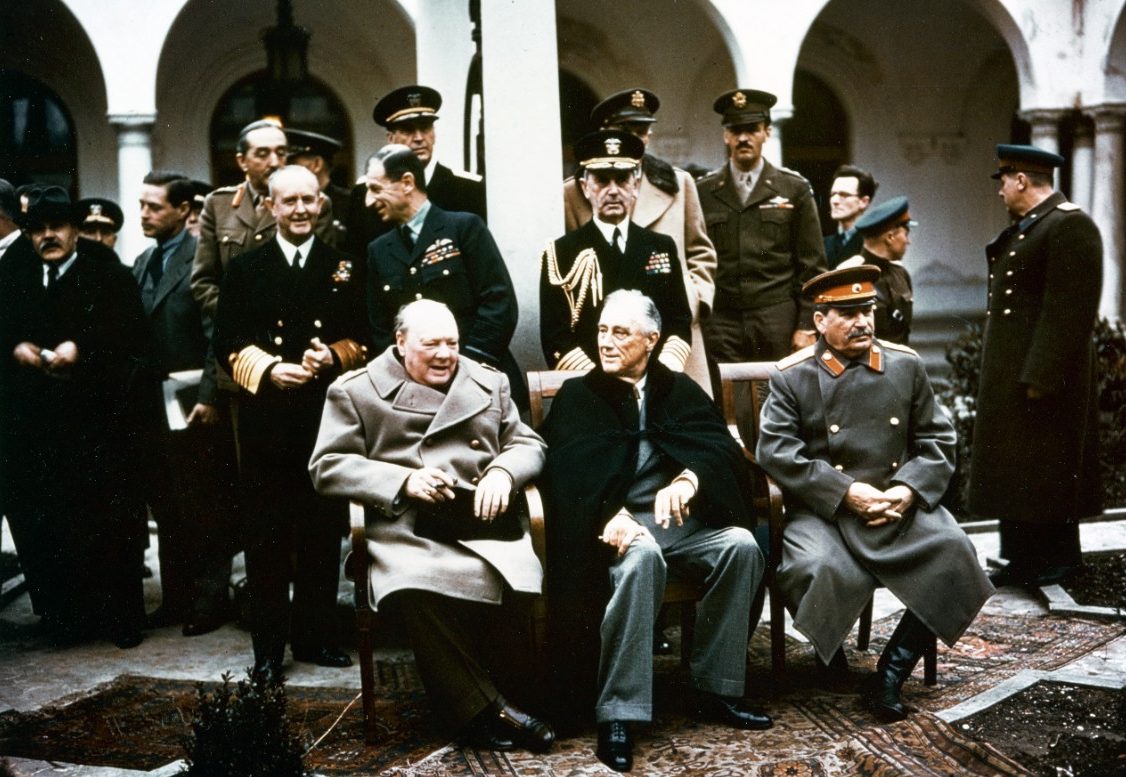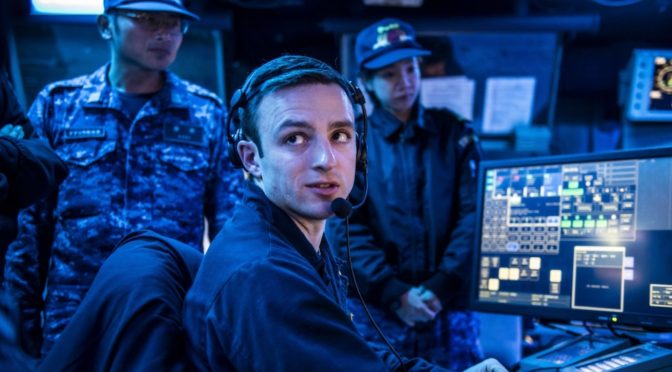The following article originally appeared in The Naval War College Review and is republished with permission. Read it in its original form here. It is republished in two parts. Read Part One here.
By David Alan Rosenberg
In 1981, the creation of the Center for Naval Warfare Studies further encouraged the shift from using war gaming primarily as a training tool toward using it for the analysis and development of strategy. The new center incorporated the old war gaming center, along with the Center for Advanced Research, the Naval War College Press, and the new Strategic Studies Group, made up of front-running Navy and Marine officers who were chosen by and reported directly to the Chief of Naval Operations. The center was to serve as a vehicle for the development and dissemination of naval strategy or, more accurately, to define the Navy’s place in national strategy.
The establishment of the new center meant greater responsibilities for the NFOIO detachment. To meet the challenge, the size of the detachment was increased. As of 1984, it was composed of seven naval officers, two civilian analysts, and two enlisted personnel for office and library support. Reflecting its increased capability, the detachment was assigned the additional task of providing the director of the new Center for Naval Warfare Studies and the Strategic Studies Group with intelligence support and background information “‘on matters pertaining to Soviet strategy and doctrine.’’ An eighth officer was added to the now redesignated Navy Operational Intelligence Center (NAVOPINCEN) detachment in 1986.
Presenting the Soviet side in war gaming and analysis, whether for the purpose of training officers or with the intention of shaping naval and national strategy, is a large, intricate, and time-consuming task. The 1986-1987 war gaming schedule listed more than 50 separate games or exercises. In addition, gaming personnel and NAVOPINCEN detachment members participated in training sessions and seminars related to war gaming. Since completion of the new enhanced naval war gaming computer system in early 1987, it has become possible for more and more games to be played at remote sites, including fleet headquarters in Norfolk, Pearl Harbor, and even London. This will decrease the amount of travel required of fleet personnel to Newport, allowing state of- the-art Navy war gaming to reach more commands. However, War Gaming Department and NAVOPINCEN detachment members have found that such remote gaming increases rather than decreases their workload because pregame preparations usually require as much, if not more, travel and advance planning as games played solely in Sims Hall.
Fewer than 40 percent of the games played at Newport are sponsored by the Naval War College, and an even smaller percentage are used purely for the instruction of War College students. The game sponsors today are active operational commanders and strategic planners in Washington. Among the game sponsors for 1986-1987 were the Commanders of the Atlantic and Pacific Fleets and U.S. Naval Forces Europe; the Supreme Allied Commander, Atlantic; the NATO Strike Fleet Atlantic; the Fleet Marine Force, Atlantic; the U.S. Seventh Fleet; Submarine Group Two in New London; and the Strategic Concepts Branch and the Director of Naval Warfare in the Office of the Chief of Naval Operations. The game sponsor sets the parameters of the simulation to be played, including the general questions that need to be explored and the range of specific tactical and strategic issues that should be included during game play. Each one of these games has a War Gaming Department staff mentor assigned to it as a scenario design representative, and a NAVOPINCEN detachment member assigned as a representative to develop ways for the opposition to be played.10
The NAVOPINCEN detachment’s approach to playing the opposition in war games is more of an art than a science. The detachment draws heavily on data from the Washington intelligence community, including the Navy Operational Intelligence Center in Suitland, Maryland, the rest of the Naval Intelligence Community, plus the National Security Agency, Central Intelligence Agency, and Defense Intelligence Agency. The Operational Intelligence Center provides data on current Soviet operations and exercise activity, while National Intelligence Estimates and Soviet open-source literature provide reference points for building scenarios and conducting the games. In games involving joint action, the detachment can call upon the services of two Army Fellows assigned to Newport for two year tours to assist the War Gaming Department in getting ground operations correct. One of the Army Fellows is a military intelligence officer; the other is a combat arms professional. In addition, the NAVOPINCEN detachment regularly calls upon the U.S. Air Force “Checkmate” office and other Air Force commands for answers to questions regarding the simulation of Soviet air operations.
Before a game begins, NAVOPINCEN detachment members engage in extensive preparations. They work with the game sponsor and the War Gaming Department design representative in setting up scenarios that are realistic and yet tailored to facilitate analysis of the issues and courses of action the sponsor is concerned about testing. Opposing simulation forces are built up, computer databases prepared, and scenarios worked and reworked to fit the requirements of the game. By the time the players arrive and the game begins, much of the work of playing or being “Red” has been completed.
It is never possible to achieve complete accuracy and fidelity in playing the opposition. War games are by their nature only approximations of combat situations. Furthermore, intelligence is never perfect, and questions inevitably arise for which there are no answers. The problem of incomplete intelligence is compounded by the pressures of game play. When the NAVOPINCEN detachment is presented with an unexpected choice, it may be possible to come up with relevant data by doing a quick search of the literature or querying intelligence community sources. Sometimes, to expedite the game, the detachment is forced to fall back on the cumulative experience of its members in making a “best military judgment” regarding likely courses of Soviet action. In such instances detachment members are nagged by the thought that the answer might have been found if only there had been time to look for it, and the choice that was made may not have been consistent with the best possible information. The professional ‘Red’ team players find it sobering to consider that “rightly or wrongly, we are leaving high-ranking military officers with a certain perception of how Red is going to fight,” although every decision is not backed by hard data.11
This problem is further compounded when intelligence is available but cannot be used without violating security. The NAVOPINCEN team makes use of even the most sensitive information in preparing its scenarios, but once play begins, caution is in order since only a few of the games are classified above the “Secret” level. Detachment members will utilize their knowledge of highly classified information during gameplay only if this can be done without revealing the source. It may be necessary on occasion to play the Soviet side with less than total fidelity and precision in order to avoid Compromising critical intelligence sources.
The NAVOPINCEN detachment also faces another more mundane, but not insignificant, constraint on how realistically it can portray Soviet forces. The U.S. side in any given game will always have the use of far more computer terminals than the Soviet side. This is a logical arrangement since U.S. choices, not Soviet ones, are the focus of the game. Nevertheless, it does mean that the detachment is not able to present the actions of Soviet forces in full detail. For example, it is particularly difficult to present Soviet air operations on a full scale basis with this constraint. The shortage of control terminals has occasionally turned out to be a blessing in disguise. The fewer terminals “Red” has available, the fewer dedicated “Red” personnel are needed to man them. In a sense, the NAVOPINCEN detachment gamers face fewer command, control, and communication problems this way. Still, the lack of a fully staffed “Red” side means that those on the U.S. side may not have as complete a simulated picture as possible of the array of threats they would be facing in a real war.
There are also some larger questions about the design and use of the war games which are of concern to those who have served with or played against the NAVOPINCEN detachment. These are not specific constraints on how accurately the Soviets can be portrayed, but more general problems that are particularly apparent to those charged with being “Red.”
First, it should be noted that not all war games are alike. Some have a comparatively narrow tactical focus, i.e., examining military issues and possible options for the use of set numbers and types of forces to resolve certain specific regional problems. Others are strategic in orientation, looking at a large number of issues over a variety of regions and with a great array of military forces. These are more scenario and personality dependent; the designers and players have greater latitude in making decisions because of the complexity inherent in large numbers of variables. Both tactical and strategic games have their uses. Tactical games are most useful in assessing, through computer modeling, the technical boundaries and general parameters of military options. Strategic games are best characterized as politico military simulations whereby the military interaction is dependent on game-oriented political decisions rather than on more narrow technical and military considerations. They stimulate creative strategic thinking and are most useful in giving the players an opportunity to role-play decision making in wartime and crisis situations.12
Both strategic and tactical games often begin with a scenario that is strategically realistic but politically improbable at best. This inconsistency arises because, in order to mount a game, it is necessary to posit an outbreak of hostilities between the Soviet Union and the United States, something both nations are, in fact, anxious to avoid. Since the United States never acts as the aggressor in war games, it is often necessary to “force” the Soviet Union to engage in open hostilities without adequately explaining its reasons for doing so.
A related problem revolves around the question of the “first salvo.” While the large, strategic global war games begin in peacetime or a crisis, many smaller games (particularly tactical exercises) open after war has actually started. To focus on naval engagements that permit room for American commanders to take the initiative, it is often necessary to skip over the Soviet attack that signaled the outbreak of the war and zero in on the U.S. response. The impact of the initial attack is merely written into the background scenario. It is never described as so devastating as to preclude response, since that would abort the game before it had begun. The Soviet Union, however, attaches great strategic importance to the first salvo and is likely to make it as devastating as possible. Skipping over this phase of the conflict could easily leave the wrong impression with those playing the game.
Navy and NAVOPINCEN detachment concerns about the battle of the first salvo have not been ignored at Newport. A number of specific games have been designed to focus on this phase of the conflict, and the experience gained from them has made the U.S. Navy much smarter about the first salvo challenge and, theoretically at least, more capable of dealing with it, both in simulation and real life. Real war is always uncertain, however, and students and officers who begin play in war games without experiencing and countering the first salvo need to be constantly aware that there is another dimension to the problem that they have missed, and about which they cannot become complacent.
War games are, of course, only best approximations of operational reality. Even discounting the problem of a summary initial scenario, the time frame in which war games are played does not permit a natural unfolding of events. Most war games last only a matter of hours, days, or, at the very most, weeks. Although it is possible to telescope time to simulate a somewhat longer period, it is impossible to game a prolonged conflict realistically under these conditions. The pressure of artificial time constraints distorts the interaction between the opposing sides and may result in unrealistic decision making.
Despite the best efforts of the War Gaming Department and the NAVOPINCEN detachment to make the scenarios, simulations, and interactions realistic, war games are competitive exercises in which the will to win is often stronger than the desire to learn. This is particularly true when those playing are knowledgeable operators who have come to Newport to test tactical concepts. They often have both a good grasp of the “Blue” side and a sophisticated understanding of the Soviet side; further, they have experience in playing war games against the NAVOPINCEN opposition teams at the war gaming center. Reality can be sacrificed when players become too familiar with the game. Those who have had experience with how the NAVOPINCEN detachment plays the opposition can often begin to take that experience into account in making subsequent war game decisions. They will become increasingly proficient at playing the gamers, rather than the game.
This is not necessarily a negative aspect. The war gaming program at Newport is intended to give players experience in thinking about how the Soviet Union does things so that they will not be surprised in real life. To the extent that “Blue” understands what ‘‘Red” is likely to do (even if only as a result of playing the gamers, not the opposition they represent), the purpose of the gaming experience will be served. It is imperative, however, that the “Blue”’ gamers be aware that tactics and techniques confirmed through this sort of game play may not be so validated in a real engagement.
One important way to avoid such misplaced lessons is for “Red” to avoid playing his side of the games so consistently as to become predictable. It may be difficult to introduce inconsistency deliberately, while still being faithful to the intelligence that has been gathered and analyzed so painstakingly over time. But the realities of naval (or any other kind of) warfare make it necessary, however, to think through to the unexpected on the game floor rather than at sea. With the best recent intelligence providing a solid base on which to build, the challenge for the “Red” war gamers is to find ways of simulating not just what we think “Red” would do in the event of war, but also what “Red” could do. This requires additional attention to nuance and detail, as well as increased dedication to the already difficult job of thinking “Red.”
Finally, it must always be remembered that war games are not surrogate history. The conflict they simulate did not actually happen. The lessons they teach are not lessons of history. Outcomes will vary even if the same game with the same scenario and the same players is repeated. Neither the scenario nor the outcome of any particular game is likely to be replicated in the real world. War gaming can be used legitimately to raise questions and identify potential problems, but beyond this it must be treated with caution. Those who cite the outcomes of war games as evidence in support of a particular theory or strategy may well be building a house on sand.
This is especially true when the conclusions (war gamers prefer the terms “insight” and ‘”issues”) being drawn from the games focus on the actions taken by the opposition. The members of the NAVOPINCEN detachment do their job well and faithfully, but they can only make educated guesses as to what the Soviet Union might or might not choose to do in combat. To conclude that the Soviet Union is likely to respond to a particular situation in a certain way because of what happened in a war game is to distort and misuse the war gaming concept.
During the past century, war gaming has proved itself a valuable tool in preparing officers for combat and strategic decision making. Although students at the Naval War College have less exposure to war gaming today than they did in the interwar period, it is likely to remain an important element in the curriculum.
The need for accurate intelligence about probable opponents has been recognized as a critical element of war gaming since the interwar period. The naval intelligence community currently plays a crucial role in war gaming at the Naval War College, providing systematic, detailed information about Soviet forces and doctrine during both the design and the implementation of the games, and seeking to “think Red” in order to give players a consistent, credible opponent.
Despite the constraints they face, the officers and analysts of the NAVOPINCEN detachment have every reason to be proud of their record. By playing a credible Soviet opponent, they have injected a measure of realism into war games that otherwise might be exercises in mirror imaging or even wishful thinking. Their professionalism generates the kind of challenge against which those engaged in war gaming can truly test their skills and their strategies.
Nevertheless, the current popularity of war gaming raises questions that deserve careful consideration. If war games are not surrogate history, just what role can and should they play in the development of strategy? To a large extent it comes down to the experience of each individual in the game. Just as in strategic planning, where it is not the plan but the planner who is important for the future, so too in war gaming, it is the gamer not the game. To the extent that individuals expand and test their minds in playing against a credible opposition and use that experience to inform (but not dictate) their actions and plans, the investment made in manpower, hardware, and money at Sims Hall at the Naval War College will continue to be a sound one.
David Alan Rosenberg is a Naval Reserve officer assigned to the Chief of Naval Operations Intelligence Analysis 0166 Reserve unit based at Naval Air Facility, Washington, D.C. As a civilian, he is a professor in the Strategy Department at the Naval War College.
References
10. Naval War College War Gaming Department, Operations Division, War Gaming Schedule Update, 1986-1987, 15 August 1986.
11. Robert Marshall, “Thinking Red Wargaming: Naval Issues,” unclassified brief prepared for a 1985 National Defense University War Gaming Center Conference, copy courtesy Commander Marshall,
12. For a general discussion of contemporary war gaming, its varieties, and its usefulness to planners and policymakers, see the forum on “Political and Military Gaming” with articles by Lincoln Bloomfield, Paul Bracken, Garry D. Brewer, and Lloyd H. Hoffman, Jr., in ORBIS, Winter 1984, pp. 783-822. Hoffman’s article on “Defense War Gaming,” pp. 812-822, surveys the various U.S. Government gaming organizations and types of games played.
Featured Image: A U.S. Navy commander talks with a Soviet navy captain second rank as they walk along the pier past the Soviet guided missile destroyer Boyevay. Three ships of the Soviet Pacific Fleet are in San Diego for a five-day goodwill visit. (U.S. National Archives/Scene Camera Operator: PH2 Bill Gazza)

